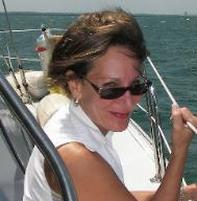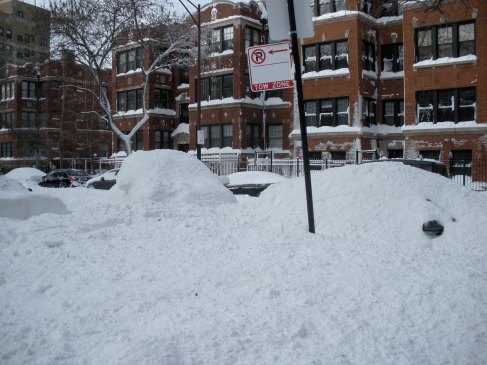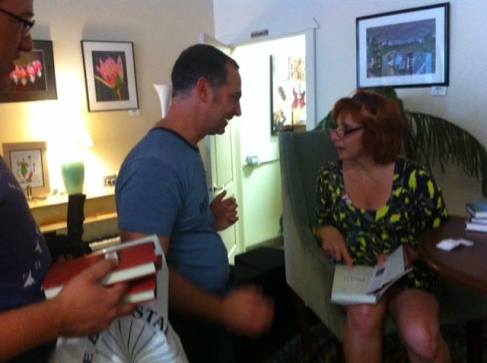|
The Fourth Annual S3Q2 & Friends Retreat took place in Beverly Shores, IN, this September. Graduating classes at Vermont College of Fine Arts MFA Program in Writing for Children and Young Adults have a tradition of naming their classes. Mine was known as The Super Secret Society of Quirk and Quill, S3Q2 for short. Since graduation, we've managed to get some of our original classmates together with other VCFA friends for a weekend writing retreat that's both productive and quirky. I mean, this year we were visited by a peacock.  Pic by Varian Johnson Pic by Varian Johnson We had a blast, and I wrote more than 10k words over the weekend. For my full report on the weekend and WAY more pictures, please visit my post at Quirk & Quill! S3Q2: Ginger Johnson, Larissa Theule, Varian Johnson, Rachel M. Wilson, & Jen Taylor Schmidt
And Friends: Amy Rose Capetta, Mary Winn Heider, Rachel Hylton, Katie Bayerl, Marianna Baer, Steve Bramucci, & Carol Brendler
0 Comments
The Writing Process Blog Tour is snowballing through my writer friends, picking up two new authors with every post! It's going to eat all the authors! But that's okay because we'll all learn fascinating things about each other's processes in the, you know, process. Michelle Knudsen, amazing author of Library Lion and the Dragons of Trelian books among other great works, tagged me, and you can read her responses here. And here are mine: What am I currently working on? I've only recently gone over first pass pages for my YA debut, Don't Touch. The fact that people are currently reading ARCs of this book is a daily distraction. A nice one, but, you know . . . This week, I've been revising a dark and spooky story called "The Game of Boys and Monsters" that will come out as a digital short from HarperTeen Impulse in October. And I'm working on a newer and more secret project that is also dark and spooky. It may or may not want to be a multi-book project. Said project and I are wrestling that out right now. I've got bruises. How does my work differ from others of its genre? Well, for one thing, I don't feel married to a particular genre. I don't think that's so unusual, but I hope to be able to work in a variety of genres over time. I'm also really interested in blending genres--I get irritated at the suggestion that there are boundaries between genres like romance and sci-fi and horror and "literary fiction." I love books like Liar by Justine Larbalestier or Imaginary Girls and 17 & Gone by Nova Ren Suma that don't fit neatly into categories. I'm super interested in reading a horror story that is "literary," whatever that means. Did somebody say Kelly Link? Yes, please! And I love reading stories that seem rooted in realism but then veer into magical realism or fantasy. I won't judge my own success at genre-blending with "The Game of Boys and Monsters," but it's something I thought about while writing it. Don't Touch is contemporary realism, but I've been influenced by works in which reality is more fluid or in which the point of view character's perception of reality is fluid. There's probably less fluidity in the final draft of this book than there was in earlier drafts, but I think some of that slippage is preserved in Caddie's point of view on her surroundings. On a totally different note, I'm excited about Don't Touch being set in the Deep South. It's where I grew up, and it's a setting that doesn't show up in YA as frequently as say, New York or LA or the suburban Midwest. Why do I write what I write? Um, because I want to, I think? Is that a terrible answer? I write things that excite and engage me. If I'm not having fun writing something--which doesn't mean the work is easy; challenging can be fun--there's probably something wrong. I'm drawn to write about things that bother me or haunt me or confuse me. For example, with "The Game of Boys and Monsters," I wanted to sort out some of my mixed feelings about stories in which sexy boyfriends turn out to be monsters. I'm drawn to writing about things I find absurd and want to poke fun at. Sometimes, I've fallen in love with a book or show that gives me a particular feeling, and I want to find my own story that gives me a similar feeling. With Don't Touch, I felt drawn to make a story around fear. A narrative has the power to organize and distill experience. A story sifts experience and makes meaning from the messiness of real life. In a way, I was writing a book that I wish I'd had to read in high school. The arc of a story resolves faster than anything does in real life, and that's comforting when you're in the middle of the mess of life. Reading gives us the opportunity to journey through an entire story arc in a relatively short period of time, and then reflect on how that arc might or might not have relevance to our own real lives. How does my individual writing process work? I seem to "write long," meaning that I tend to spill out every thought I might possibly have about a given character or theme. I write out of narrative sequence. Sometimes, I have an idea of the story arc, sometimes not, but I usually need something that feels fixed to work from--this might be a rough outline, it might be a final scene, or it might be a single strong image. Then I'm confronted with a hugely messy collection of scenes. In every novel-length project I've undertaken so far, I've found that I have way more material than one story can contain--that in fact, I have conjoined twin or triplet stories. I have to figure out where the strongest pull is coming from and cut away all the excess and more or less start over with a newly refined sense of direction. Still, in starting over, I don't delete everything. I enjoy pulling sentences and paragraphs from old drafts into new ones, working patchwork style and massaging a scene until it feels like one organic piece. I'm not saying this is my ideal process. I've been trying lately to write synopses and to give myself more direction from the beginning. While this is a good tool to keep me going and feeling like there's light at the end of the tunnel, I also accept that good things come out of wallowing around in the dark. In the midst of all stages, I write lots of notes to myself, collect images, sketch pictures, play with free-writing, interview my characters, and when I can justify it to myself, I love spending tons of hours on research. I really enjoy writing blind and free, and I enjoy revising on the scene and sentence level. The part that makes my brain crazy, and that I spend a ton of time on, is wrangling with plot on the big-picture level. So that's me. I'm tagging two more authors who'll be sharing their answers with you next week, so be sure to visit their blogs!  I have the pleasure of knowing Linden McNeilly from the MFA in Writing for Children & Young Adults program at Vermont College of Fine Arts. Linden's a brilliant writer and teacher, and with her sister, she penned a really cool nonfiction book exploring the art of map-making, Map Art Lab.  Sue LaNeve was in my class at Vermont College of Fine Arts. Now she lives on a boat -- WHAT? She's the author of the funny and touching Spanky: A Soldier's Son, about a middle grader dealing with a new school, bullies, a depressed mom, all while trying to live up to the expectation of a father who's serving in Afghanistan. Sue and Linden will both be sharing their answers on our group blog, Quirk & Quill, so be sure to check it out next Monday!
This post is from my group blog, Quirk & Quill. To read the full post, follow the link at the bottom. I've been working on a novel that begins with a deep freeze. (This pic happens to be from Chicago's awful storm of 2011 and not from the Polar Vortex, but you get the idea. Burial in ice and snow.) I write outlines, synopses, pages of notes; I write drafts full of characters that have since been discarded. My latest Scrivener file contains 13,000 words. An earlier one: 271,000. Still another: 233,000. Much of that is repeated. Some of it isn't. Sometimes, I think it's YA. Other times, it feels more middle grade. Sometimes I think it's a series, and then my brain starts to shiver. As I wander through this story, I feel lost as my girl in the snow, fighting her way through wind tunnels of ice chips that bite at her cheeks. And the weather outside matches my fictional wasteland. Read the rest of this post on Quirk & Quill . . . This post is was originally published on my group blog, Quirk & Quill. I don't usually write to music. It distracts me, but I do write with it. I have favorite music for getting into moods, connecting with characters, or inspiring story. I credit my songwriter friend, John Elliott, and his music for inspiring this post. I've written with his music many times, and his new indie album Good Goodbyes released Tuesday. When John invited me to write a review of his album, I told him I don't know anything about reviewing music. I do know I love this album, that it's evocative and inspiring, and I'm excited to try writing with it soon. Here are some ideas for writing with music, even if you're not fond of playing it while you write.
If you're up for a kick-in-the-pants, do-it-right-now challenge, try the one of the last two exercises with this video of John Elliott's "Back Where I Was" set to a single thunderstorm. I recommend making the video full screen. Share a bit of your exercise or let us know how it worked for you in comments! You can hear samples of tracks from more of John's work and see more videos of his songs here. Aside from the picture of me reading from Don't Touch at the bottom of the post, this was originally posted on Quirk & Quill. Last weekend, I had the pleasure of attending--and reading at--Sarah Aronson's book launch for Believe. I haven't read my copy yet, but Believe promises to be an intriguing exploration of the unwanted celebrity our culture thrusts on the survivors of public tragedy. It's been named an ALAN Pick, and if the book is anything like the book LAUNCH, it's going to be amazing. Planning a book launch is a daunting task, but Sarah designed this event in a unique way that made it successful on multiple levels. First, the event took place at Curt's Cafe, a mission-based non-profit that trains at-risk youth in food-service and life skills. All the food for the book launch was donated, so attendees were encouraged to donate and to buy raffle tickets to support Curt's Cafe. Allowing the event to double as a fundraiser may have encouraged more people to come. And Sarah says, "The spirit of the event IS the spirit of Curt's! I hoped we could pack the house (we did!) and help them continue to make a difference in our community." Everybody wins. Second, Sarah invited a number of local authors to participate in a group reading including Penny Blubaugh, Carol Brendler,Ilene Cooper, Brenda A. Ferber, Ken Krimstein, Jenny Meyerhoff, Ellen Reagan, Laura Ruby, Natalie Wainwright, myself, and of course, Sarah! Sarah wanted "to honor the process of writing," to share that with her friends, and to "honor the VC and MFA experience." Many of the readers attended VCFA; Laura Ruby teaches in a similar program at Hamline. The event definitely took me back to the readings at Vermont College of Fine Arts, where students and faculty often read from works in progress. It was so exciting to hear snippets of books that are in various stages of the submission and publication process. And for Sarah, the callback to VCFA had extra meaning since the first version of Believe was her graduate reading. This group reading also cultivated a great sense of community. I've long admired some of these authors but never before met them in person. Now, I've not only met them, I've heard what they're working on. And it was great to see VCFA alums like Carolyn Crimi and Linda Washington in the audience. As Sarah says, "For me, writing is all community. Over the years, the readings I've participated in have made me feel like a writer, have helped me make amazing friends. What better way to celebrate?" This was originally posted on Quirk & Quill. Heat causes expansion. Cold, contraction. Fire behind a story gives it flesh. We find our spark. The story burns. The pages fill. And once the story's full, it's time for cold. Sharp. Reflection. Contraction. In my first revision of DON'T TOUCH for my editors, I had a lot of questions to answer, lots of backstory to clarify, characters to unfold. The novel grew. When I sat down with my line-edits, I needed to focus on pace. I needed to chill out, get analytical, and SLASH with an ICY BLADE. I wanted to see how all the characters, settings, and threads fit together, so I looked to the blog of fellow VCFA grad Ingrid Sundberg. She has many excellent posts on structure, but since my book deals with OCD, it's only fitting that a post called "Obsessed wtih Story Structure" spoke to me. I love that this post encourages flexibility in design. This is not a formula. Identifying what needs tracking for a particular story can be as instructive as creating the visual itself. I made a graph tracking four settings, five plot threads, two types of scenes (flashbacks and theater scenes), and nine characters. Along the top, I also used opposing colors for alternating sections and chapters (shown in the second picture). On a separate track, I outlined all the plot points and played with lines representing tension and desire. Then as I cut, I folded over the cut pages, accordion-style. As the graph contracted, the proportions began to look nicer, and the patterns pleased me. For other sections, I was able to visualize changes without manipulating the paper. It helped me identify sections that needed trimming or a change of pace. If you're considering trying this, here are some things I learned. I got super-specific -- one block on my graph equals two pages. I would suggest starting on a larger scale. The trends and proportions should still be clear, but it won't be as painstaking. I might also start with less characters or group those who almost always appear together. For me, mapping out the plot threads was most helpful. If I had a page or more with no plot threads represented, often, it could be cut. I also found it helpful to use a single color for both a character and a plot thread that featured him or her. In my graph, the hot pink color represents Caddie's friend Mandy, the thread of their friendship, and the setting of Mandy's house, and that consistency made it easier to connect the sections of the graph. Best of all, this graph gave me the courage to SLASH without worrying about what might be lost. |
Rachel's Blog
News, events, fun stuff, serious stuff, and online doings. I kept a personal blog for years at The Storybook Girl, and I'll slowly be migrating some of those posts to this blog. Archives
April 2016
Categories
All
|











 RSS Feed
RSS Feed
